| One of the earliest
physicians was Imhotep (circa 2725BC),
portrayed on Egyptian stamps, and regarded as the Egyptian god of medicine. He
attributed the pulse rate as the resulting action of the heart. But the
earliest written information on medicine is recorded on the Egyptian Ebers
Papyrus. Illustrated on a stamp issue of Germany, the Papyrus take their name
from the German Egyptologist, Georg Moritz Ebers who discovered them between
1869 and 1873. They are believed to date from around 1500BC and make mention of
the heart's movement. |

Egypt 1992 World Health Day stamp |

Kuwait 80 fils stamp |
It was not until the
time of Hippocrates (460-377BC), the father
of medicine, that the heart was mentioned again in medical terms. He stated
that the heart was a strong muscle and went on to describe its structure, and
also hinted at the function of the heart's valves. Hippocrates appears on a
stamp issue, 'Heroes of Medicine', of the Transkei. |
| A further 500 years passed before
Claudius Galen (130-201AD), was to study
the heart in any detail and is portrayed on a Hungarian stamp. It was this
notable anatomist who laid the foundation of cardiac study and it was to be
another 1400 years before any further significant progress in the study of the
heart is recorded. Some of Galen's researches showed that he had made some
misinterpretations, but this was inevitable. These included that the heart was
not a muscle, that blood was delivered via the liver, and blood passed from one
side of the heart to the other via the septum. These functions can be seen be
seen on the stamps of Greece, Malta and Nigeria. |
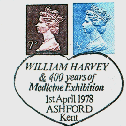
Special postmark for William Harvey |
It was not until the
16th century that significant progress was made in recording the true function
of the heart. One who tried to point out the errors of Galen's researches was
Miguel Servet (1511-1553), who was
condemned for heresy and was burnt at the stake with his writings. In those
days to speak out against Galen was to refute the teaching of the Church.
Adreus Vesalius (1514-1564) was luckier,
being a graduate of Padua University Italy, which had a high reputation of
intellectual freedom. The University assisted him in publishing his studies on
the heart in 1545. Others who contributed to research on the heart were
Abu Baker Razi - regurgitation of blood
from the aorta, Avicenna Iba Szinna - basic
circulation of the blood, and Iba Al Nafis
- how an artery conveyed blood from the heart to the lungs. |

William Harvey is shown on a "Pioneers of
Medicine" stamp issued by Hungary in 1978 |
| It was also at Padua University that the great
Englishman, William Harvey, graduated in
1602. It is interesting to note that Galileo was teaching at the University at
this time. There are many stamps depicting Harvey, including Russia, Transkei,
Argentina, Hungary and Grenada along with special postmarks and meter marks.
The hospital, named after him at Ashford in Kent, has a distinctive meter mark,
but no stamps from the Royal Mail. The Royal Mail rejected a request for a
Harvey stamp in 1977. The time he spent at Padua gave him a good grounding in
medicine and it was in 1616 that he correctly described how circulated the body
from the heart into the arteries and returned via the veins. He also identified
the heart as a pump and hinted at the existence of the capillaries, but without
a microscope he had no means of telling the role that they play. |
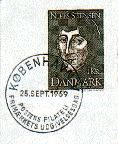
Denmark 1k stamp of 1992 for the 300th Anniversary of
Stensen's "On Solid Bodies" |
Both Vesalius and Harvey
were greatly assisted by the anatomical drawings of Leonardo da Vinci (1452-1519), who showed the
structure of the heart. He achieved this by injecting a heart, taken from a
corpse, with liquid wax; he also went on to produce detailed drawings of the
coronary arteries. It was left to Marcelo Malpigi
(1628-1694), to put the finishing touches to Harvey's work when in
1661 he described the network of pulmonary capillaries that connected the small
veins to the small arteries. This was achieved by using a simple microscope,
recently invented by Anton van Leeuwenhock
(1632-1723), and shown on the stamps of Transkei and Antigua, and
once and for all dispelled the ancient belief that blood is transformed into
flesh on the surface of the body.
Following Harvey's work there was a greater understanding of the workings of
the heart, and in 1664 the Danish anatomist, Niels
Stensen proved definitively that the heart was a set of muscles.
Then Albrecht von Hailer (1708-1777)
explained the contractions of the ventricles and echoed Galen in stating the
action of the heart was automatic, beating as it does and pumping 5,000 gallons
of blood a day as it re-circulates it around the body - some pump! |
The relationship between heart disease and
'sounding' the chest was developed by Jean N Corisart
(1755-1821), unfortunately the French stamp shows his nephew L.R.F
Corvisant! Corvisart was also mentor to Rene
Laennec who invented the monaural stethoscope, still the single most
important piece of a doctor's apparatus today.
By the beginning of the 19th Century most of the secrets of the heart had been
discovered, along with some the prime reasons for heart failure. It was during
the 1800s that Claude Bernard (1813-1878)
discovered the function of the vasometer nerves that are responsible for
regulating the blood supply by constricting or dilating the blood vessels, and
Ivan Pavlov, the physiologist, detailed the
physical and chemical actions of the heart. In the area of cardiovascular
disease, Sir William Osler made a major
scientific contribution to medical research.
As we move into the 20th Century, we have August
Krough being awarded the Nobel Prize for his work on the exchange of
oxygen and carbon dioxide in the lung tissue and William Cushing performing pioneering work in
experimental cardiac surgery. This US pioneer now has a hospital named after
him at Framingham, Massachusetts. |
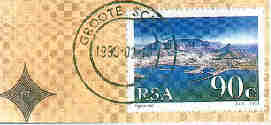 |
Christiaan Barnard, seen on a 1997 Medical
Pioneers stamp from Dominica (above) pioneered heart transplantation at Groote
Schuur Hospital, South Africa in 1967 |
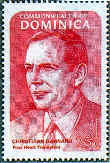 |
| These were exciting times in cardiology, but
even greater events were to unfold and in 1967 you could be given a new heart!
Yes, a heart transplant! Indeed, this is how this article came to be written,
the author himself having received a "new heart" as explained below,
and heart transplantation can now be found on the stamps of South Africa,
Granada, Spain and Greece. |
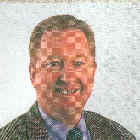 |
'The Heart is Life'.
Never have four words meant so much! Steve Boorn received a heart transplant at
Harefield Hospital in December 1991, performed by Prof. Magdi Yacoub and his
team. Prof. Yacoub was awarded a knighthood by Her Majesty The Queen in the
1992 New Years Honours List.
In the early stages of recovery, following the transplant, Steve Boorn took up
philately and decided to prepare a thematic collection based on the heart.
Having struggled through post transplant surgery and all the effects of
rehabilitation drug therapy, life is now just what the doctor ordered! Steve
Boorn is President of Hayling Island and District Stamp Club, a member of the
British Thematic Association and of the National Philatelic Society.
|
|

